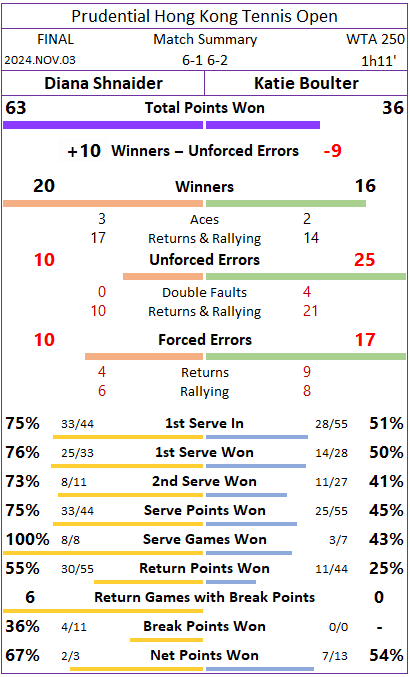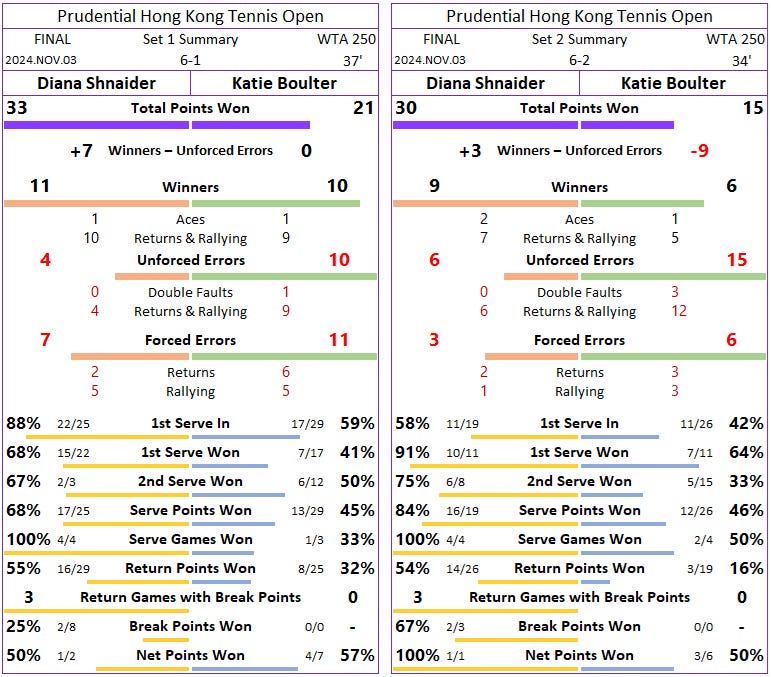Shnaider vs Boulter: Hong Kong Final Analysis (WTA 250)
Shnaider did very little wrong as she crushed Boulter to win her 4th Tour title of the season
Diana Shnaider (WTA #16) ended a sensational first full season on the WTA Tour with yet another title, her fourth of the year and young career. Only Aryna Sabalenka (with 4) and Iga Swiatek (with 5) were able to match or exceed Shnaider’s trophy tally in 2024.
Another remarkable accolade for the 20-year old is her unbeaten record after 10 matches played in Tour events as the top seed. She clinched the Hong Kong title just as she did it at WTA 250 Budapest.
With her season-ending triumph, Shnaider rose to a career-high ranking of #12. She will finish the year with a 55-23 win-loss record, Tour titles on all surfaces - discussed here - and a silver medal at the Paris Olympics doubles competition.
An unforgettable 2024 season!
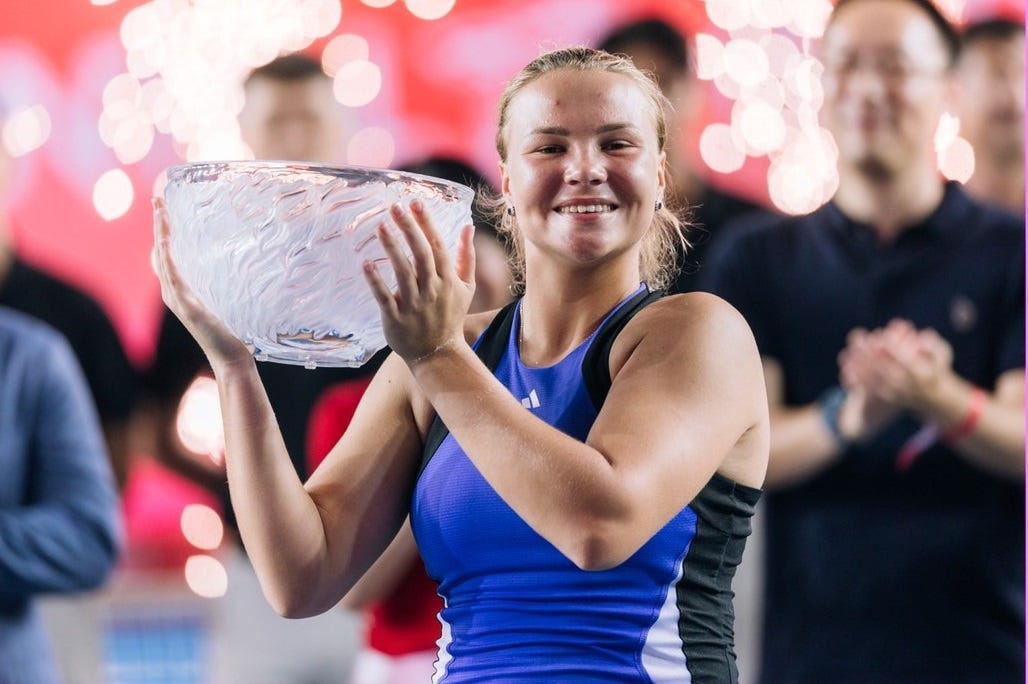
The 2024 Prudential Hong Kong Tennis Open final was a clash between the top-2 seeds, Shnaider and Katie Boulter (WTA #33). As promising as this matchup looked on paper, it delivered a short and one-sided title decider. Shnaider simply crushed Boulter, winning 10 of the first 11 games before completing a 6-1, 6-2 victory.
For the first part of the match, Boulter managed to keep up with Shnaider’s winner count (10 to 11, in set 1). But the British was a lot more up-and-down, having trouble controlling unforced errors and struggling on return.
Set 1
Winners: Shnaider 11 / Boulter 10
Unforced errors: Shnaider 4 / Boulter 10
Winners-to-unforced errors: Shnaider +7 / Boulter 0
Returns errors: Shnaider 2 / Boulter 7
In the second set, Boulter’s play dropped. Winners fell to 6 and unforced errors jumped to 15, resulting in a -9 differential. Shnaider finished the set +3, 12 points better than Boulter in that metric, after 9 winners and barely any errors (6 unforced errors and 9 total errors).
Set 2
Winners: Shnaider 9 / Boulter 6
Unforced errors: Shnaider 6 / Boulter 15
Winners-to-unforced errors: Shnaider +3 / Boulter -9
Return errors: Shnaider 4 / Boulter 6
The following points are great examples of Shnaider’s outstanding level on the day. They show two difficult shots converted into beautiful winners.
📺source: WTA Tv
While Shnaider came up with some magical strokes, in the end she prevailed by accumulating 23 fewer errors (20 vs 43), in particular 15 fewer unforced errors (10 vs 25).
The top seed also enjoyed an excellent serving performance, making 75% of 1st serves and finishing with win-rates of 76% behind 1st serves and 73% behind 2nd serves. She sailed through the final without facing a break point.
1. Short points provided most of the winning margin
Breakdown of points won by rally length showed that Shnaider ended with a huge 18-point advantage in rallies decided within the first 4 shots (41 to 23).
A closer look revealed that most of that difference was established by 1-shot and 4-shot rallies (marked by red boxes, above).
Boulter’s struggles on return directly accounted for the 16-8 score favouring Shnaider in 1-shot points.
The British accumulated 13 return errors while finding the court in only 63% of her return, against 6 return errors and 85% returns in play from Shnaider.
Return Performances
Winning returns: Shnaider 2 / Boulter 3
Errors: Shnaider 6 / Boulter 13
Returns in play: Shnaider 85% / Boulter 63%
Boulter’s returning woes were fairly global. She missed from both sides and against 1st and 2nd serves.
Boulter’s Return Errors
Forehand 6 / Backhand 7
vs 1st serves: 8
vs 2nd serves: 5
Shnaider’s superior return performance was not limited to putting more balls in play and helps explain her 10-point advantage in 4-shot rallies (12 to 2).
Despite hitting 1 fewer winning return (2 to 3), Shnaider was able to hit several quality replies that set up 6 winning strokes in her following shot, the “return+1”.
→ A couple of Shnaider “return+1” winners following good returns
The extra pressure this exerted on Boulter led the British to accumulate 7 “serve+2” errors.
“Return+1”
Shnaider: 6 winning shots / 4 errors
Boulter: 1 winning shot / 6 errors
“Serve+2” errors
Shnaider: 1 (1 unforced error)
Boulter: 7 (6 unforced errors + 1 forced error)
By contrast, Shnaider enjoyed much smoother times on her serve, making just 1 “serve+2” error and having Boulter strike a single winning “return+1”.
2. Rallying
Unable to outserve her opponent and with worse return numbers, Boulter had to outrally Shnaider if she were to win the match. But the opposite happened.
Shnaider was dominant once rallies developed, finishing with a 41-25 edge.
The young Russian ruled from the back of the court, prevailing in 33 of 51 baseline duels (65%) and winning 62% (39/63) of her baseline points.
Boulter could only counter with 18 baseline points won out of 53 played, for a low 34% baseline win-rate.
3. Boulter’s backhand
As many as 14 rallies ended on a Boulter backhand error.
Going into a match against a lefty like Shnaider, it was guaranteed that Boulter’s backhand would be under fire. Ultimately, it didn’t hold up enough.
Boulter totalled 21 backhand errors, including 12 unforced errors, with just 4 backhand winners. Compared to Shnaider’s backhand performance, Boulter was 16 points worse (-17 to -1).
Forehand Performances
Shnaider: 10 winners / 12 errors = -2
Boulter: 10 winners / 17 errors = -7
Backhand Performances
Shnaider: 7 winners / 8 errors = -1
Boulter: 4 winners / 21 errors = -17
Boulter’s backhand was particularly error-prone on down the line shots, accumulating 7 unforced errors with a single winning shot (marked by blue box, below).
Shnaider did a lot better when going down the line, as shown by the numbers highlighted by the green.
In fact, by looking at the table it becomes evident that Shnaider did well whatever shot she tried. On the day, she was on such a different level!

4. To beat Shnaider in a final, you must take her forehand into the red
From the forehand side, Shnaider hit 10 winners with 5 unforced errors, and 14 winning shots with 12 errors.
Shnaider’s Forehand Performance
14 winning shots: 10 winners + 4 forcing shots
12 errors: 5 unforced errors + 7 forced errors
As we compared Shnaider’s forehand numbers in all 6 finals she played this year across all levels (analyses available in our archive), a clear separation between her 5 wins and the single loss in the Charleston WTA 125 final became evident.
Regardless if we used “winners-to-unforced errors” differentials or broader “winning shots-errors” metrics, the conclusion was always the same:
Whenever Shnaider’s forehand ended with a positive differential, she triumphed. In the single occasion her forehand was in the red and accumulated more unforced errors than winners or more total errors than winning shots, she lost.
Shnaider is known for having a big forehand. This data goes a bit further, suggesting that she is able to bring it in most of her high-stake matches and its performance ends up linked to the final outcome.
Diana Shnaider (WTA #16, seed 1) vs Katie Boulter (WTA #33, seed 2)
2024 Hong Kong Final - Match Data
*** Due to streaming loss, some stats are missing 1 point won by Shnaider in the opening game of the match
Set by Set Stats
Rally Length
Strokes Breakdown
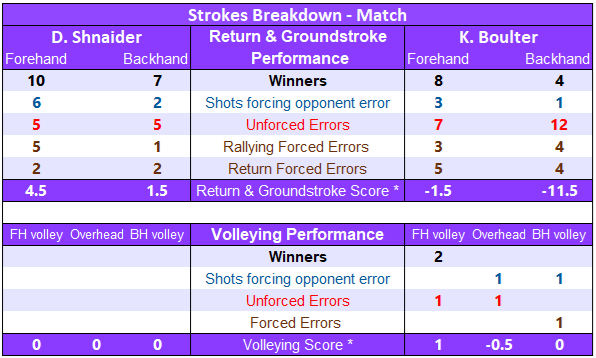
Serve and Return
1st Serves
2nd Serves
Return & rallying performance


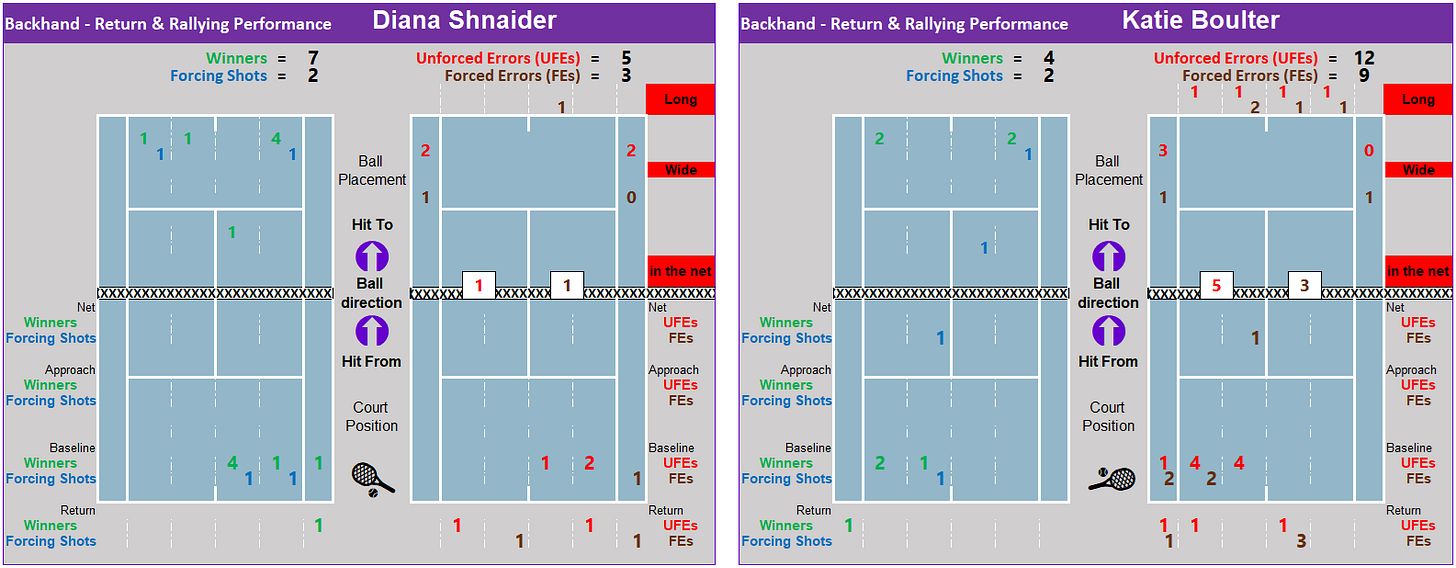
Points won breakdown
This final section gives a last, broader look at the match by presenting how each player won points. Points are listed according to their frequency (highest to lowest) and are named in relation to the last touch on the ball. For simplicity, groundstrokes hit from the 5th shot onwards are grouped together.
Breakdown by side (FHs or BHs)

Breakdown by error type (UFEs or FEs)

To find out more about the stats published here, please visit the following post.
While we follow the same criteria used on all major tennis events, our stats are collected through our own video analysis and are not official WTA or ITF stats.
Thanks for reading!
— Tennis Inside Numbers




